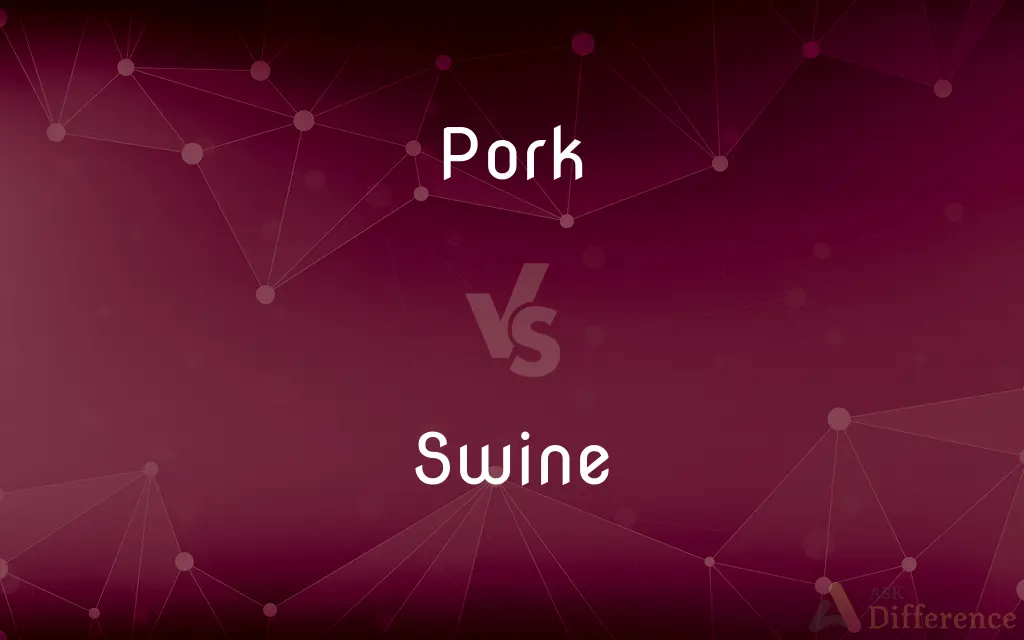Pork vs. Swine — What's the Difference?
By Maham Liaqat & Fiza Rafique — Updated on April 22, 2024
Pork refers to the meat from a pig, commonly consumed as food, whereas swine denotes the animal species as a whole, including both domestic and wild varieties.

Difference Between Pork and Swine
Table of Contents
ADVERTISEMENT
Key Differences
Pork is specifically the culinary term for meat derived from domestic pigs, often featured in various cuisines around the world. On the other hand, swine is a broader term that refers to any member of the pig family, including both domestic pigs and their wild relatives. This distinction is crucial in contexts like farming and biology, where 'swine' can refer to the entire genus encompassing multiple breeds and species, while in a culinary context, 'pork' exclusively describes the type of meat consumed.
Pork is processed and prepared in numerous ways to produce a variety of dishes, such as bacon, ham, and sausages. In contrast, the term swine is rarely associated with food products but is instead used more generally in agricultural and scientific communities. This reflects the specialized use of each term depending on the context—culinary versus agricultural.
The market for pork is economically significant, with pork products being a major part of the meat industry. Swine, however, relates more to the breeding and rearing of pigs for various purposes, including meat production, which indirectly impacts the pork market. This economic aspect highlights different facets of human interaction with pigs, whether as livestock or as a food source.
In terms of cultural significance, pork holds various taboos and dietary restrictions across different religions and cultures, impacting its consumption patterns. Swine, by being the general term for the animal, does not carry these specific cultural connotations but is recognized universally in discussions about animal species.
Health discussions around pork often focus on its dietary impacts, such as cholesterol and fat content, which can affect human health. Swine, in a broader sense, are also discussed in health contexts, particularly in terms of diseases that can affect pigs and potentially transfer to humans, such as swine flu. These health considerations reflect the distinct ways in which pigs are regarded as food sources and as carriers of disease.
ADVERTISEMENT
Comparison Chart
Definition
Meat from domestic pigs.
Any member of the pig family.
Usage Context
Culinary.
Agricultural and scientific.
Economic Role
Major part of the meat industry.
Important in breeding and rearing for various purposes.
Cultural Significance
Subject to dietary restrictions in various cultures.
Generally recognized without specific dietary connotations.
Health Relevance
Discussions often about dietary impacts.
Concerns include diseases affecting pigs and potential zoonotic transfer.
Compare with Definitions
Pork
Pulled pork.
Pulled pork sandwiches are a staple at many Southern diners.
Swine
Swine breeding.
Swine breeding focuses on improving traits like size and meat quality.
Pork
Pork loin.
Pork loin is prized for its tenderness and flavor when cooked properly.
Swine
Swineherd.
The swineherd carefully tended to the pigs, ensuring they were healthy and well-fed.
Pork
Fresh pork.
The chef prepared a roast using fresh pork from the local farm.
Swine
Wild swine.
Wild swine, such as boars, are often more aggressive than their domestic counterparts.
Pork
Salted pork.
Salted pork is often used in traditional stews and soups.
Swine
Swine flu.
Swine flu is a respiratory disease that can also infect humans.
Pork
Smoked pork.
Smoked pork ribs are a favorite at American barbecues.
Swine
Domestic swine.
Domestic swine are raised for both meat production and breeding purposes.
Pork
Pork is the culinary name for the meat of a domestic pig (Sus scrofa domesticus). It is the most commonly consumed meat worldwide, with evidence of pig husbandry dating back to 5000 BC.Pork is eaten both freshly cooked and preserved.
Swine
Any of various omnivorous, even-toed ungulates of the family Suidae, having a stout body with thick skin, a short neck, and a movable snout, especially the domesticated pig.
Pork
The flesh of a pig or hog used as food.
Swine
A person regarded as contemptible or disgusting.
Pork
Government funds, appointments, or benefits dispensed or legislated by politicians to gain favor with their constituents
"However much [the voters] may distrust Congress and dislike pork, the advantages of being represented by an incumbent with seniority are hard to deny" (Richard Lacayo).
Swine
A pig the animal.
Pork
To eat ravenously; gorge oneself. Used with out.
Swine
(pejorative) A contemptible person plural swines.
Pork
To become fat. Used with out.
Swine
A police officer; a "pig".
Pork
(uncountable) The meat of a pig; swineflesh.
The cafeteria serves pork on Tuesdays.
Swine
Something difficult or awkward; a pain.
That old car is a swine to manoeuvre.
Pork
Funding proposed or requested by a member of Congress for special interests or their constituency as opposed to the good of the country as a whole.
Swine
(archaic) sow
Pork
Law enforcement, those who side with criminal prosecution
Swine
Any animal of the hog kind, especially one of the domestical species. Swine secrete a large amount of subcutaneous fat, which, when extracted, is known as lard. The male is specifically called boar, the female, sow, and the young, pig. See Hog.
Pork
(slang) A shag; a fuck; an act of coitus.
Swine
Stout-bodied short-legged omnivorous animals
Pork
The flesh of swine, fresh or salted, used for food.
Pork
Meat from a domestic hog or pig
Pork
A legislative appropriation designed to ingratiate legislators with their constituents
Common Curiosities
What is pork commonly used for?
Pork is commonly used for various food products including bacon, ham, and sausages.
How are pork and swine related?
Pork is the meat derived from swine, which are the animals themselves.
What is the significance of swine in agriculture?
Swine play a significant role in agriculture, primarily for meat production and sometimes for their by-products.
Is pork healthy to eat?
While pork can be part of a healthy diet, it is higher in fat and should be consumed in moderation.
How is pork prepared in different cultures?
Pork is prepared in various ways, from smoked and cured to roasted and fried, depending on cultural preferences.
What are common diseases affecting swine?
Common diseases affecting swine include swine fever, foot and mouth disease, and swine flu.
Can swine transmit diseases to humans?
Yes, swine can transmit diseases like swine flu to humans.
Why might some cultures avoid pork?
Some cultures avoid pork due to religious dietary laws, such as in Judaism and Islam.
What are the types of swine?
Types of swine include domestic pigs and wild species like the boar.
What are popular pork dishes worldwide?
Popular pork dishes include Italian prosciutto, Chinese char siu, and American pulled pork.
Are there environmental concerns related to swine farming?
Yes, swine farming can lead to environmental concerns like methane emissions and waste management issues.
What are the economic benefits of swine farming?
The economic benefits of swine farming include meat production and the supply of leather and bristles.
How is pork categorized in the meat industry?
In the meat industry, pork is categorized based on cuts, such as loin, ribs, and shoulder.
How does swine breeding affect pork quality?
Swine breeding directly affects pork quality, focusing on traits such as meat yield and flavor.
How can swine impact local ecosystems if not managed properly?
Unmanaged swine can become invasive and disrupt local ecosystems, particularly in cases of wild boar populations.
Share Your Discovery

Previous Comparison
Laid vs. Lain
Next Comparison
Marquetry vs. IntarsiaAuthor Spotlight
Written by
Maham LiaqatCo-written by
Fiza RafiqueFiza Rafique is a skilled content writer at AskDifference.com, where she meticulously refines and enhances written pieces. Drawing from her vast editorial expertise, Fiza ensures clarity, accuracy, and precision in every article. Passionate about language, she continually seeks to elevate the quality of content for readers worldwide.
















































